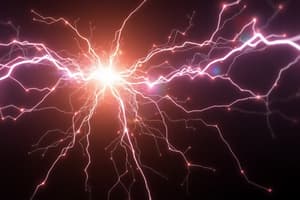Podcast
Questions and Answers
What is the unit of electric charge?
What is the unit of electric charge?
- Ohm
- Volt
- Coulomb (correct)
- Ampere
What is the flow of electric charge?
What is the flow of electric charge?
- Electric potential
- Electric current (correct)
- Resistance
- Capacitance
What is the relationship between voltage, current, and resistance?
What is the relationship between voltage, current, and resistance?
- I = V/R
- V = IR (correct)
- V = I/R
- R = V/I
What is the ability of a device to store electric charge?
What is the ability of a device to store electric charge?
What is the principle behind many electric devices, including generators and transformers?
What is the principle behind many electric devices, including generators and transformers?
What is the difference in electric potential between two points?
What is the difference in electric potential between two points?
What is the opposition to the flow of electric current?
What is the opposition to the flow of electric current?
What is the behavior of electric circuits described by?
What is the behavior of electric circuits described by?
What is the unit of capacitance?
What is the unit of capacitance?
What is the law that describes the relationship between the magnetic flux and the induced electromotive force (EMF)?
What is the law that describes the relationship between the magnetic flux and the induced electromotive force (EMF)?
Flashcards are hidden until you start studying
Study Notes
Electricity
Electric Charge
- Electric charge is a fundamental property of matter that can be positive or negative.
- Like charges repel each other, while opposite charges attract each other.
- The unit of electric charge is the coulomb (C).
Electric Current
- Electric current is the flow of electric charge, typically measured in amperes (A).
- It is defined as the rate of flow of charge, with 1 A = 1 C/s.
- Current can be either direct (DC) or alternating (AC).
Electric Potential
- Electric potential, also known as voltage, is the potential energy per unit charge.
- It is measured in volts (V), with 1 V = 1 J/C.
- Electric potential difference is the difference in electric potential between two points.
Resistance
- Resistance is the opposition to the flow of electric current, measured in ohms (Ω).
- It depends on the material, length, and cross-sectional area of the conductor.
- Ohm's Law states that voltage (V) is equal to current (I) multiplied by resistance (R): V = IR.
Electric Circuits
- Electric circuits consist of conductors, resistors, and sources of voltage.
- Series circuits have components connected one after the other, while parallel circuits have components connected between the same two points.
- Kirchhoff's Laws describe the behavior of electric circuits: Kirchhoff's Current Law (KCL) and Kirchhoff's Voltage Law (KVL).
Capacitance
- Capacitance is the ability of a device to store electric charge.
- It is measured in farads (F), with 1 F = 1 C/V.
- Capacitors store energy in an electric field and can be connected in series or parallel.
Electromagnetic Induction
- Electromagnetic induction is the production of an electric current in a conductor when it is placed in a changing magnetic field.
- It is the principle behind many electric devices, including generators and transformers.
- Faraday's Law of Induction describes the relationship between the magnetic flux and the induced electromotive force (EMF).
Electric Charge
- Electric charge is a fundamental property of matter that can be either positive or negative.
- Like charges repel each other, while opposite charges attract each other.
- The unit of electric charge is the coulomb (C).
Electric Current
- Electric current is the flow of electric charge, typically measured in amperes (A).
- It is defined as the rate of flow of charge, with 1 A = 1 C/s.
- Current can be either direct (DC) or alternating (AC).
Electric Potential
- Electric potential, also known as voltage, is the potential energy per unit charge.
- It is measured in volts (V), with 1 V = 1 J/C.
- Electric potential difference is the difference in electric potential between two points.
Resistance
- Resistance is the opposition to the flow of electric current, measured in ohms (Ω).
- It depends on the material, length, and cross-sectional area of the conductor.
- Ohm's Law states that voltage (V) is equal to current (I) multiplied by resistance (R): V = IR.
Electric Circuits
- Electric circuits consist of conductors, resistors, and sources of voltage.
- Series circuits have components connected one after the other, while parallel circuits have components connected between the same two points.
- Kirchhoff's Laws describe the behavior of electric circuits: Kirchhoff's Current Law (KCL) and Kirchhoff's Voltage Law (KVL).
Capacitance
- Capacitance is the ability of a device to store electric charge.
- It is measured in farads (F), with 1 F = 1 C/V.
- Capacitors store energy in an electric field and can be connected in series or parallel.
Electromagnetic Induction
- Electromagnetic induction is the production of an electric current in a conductor when it is placed in a changing magnetic field.
- It is the principle behind many electric devices, including generators and transformers.
- Faraday's Law of Induction describes the relationship between the magnetic flux and the induced electromotive force (EMF).
Studying That Suits You
Use AI to generate personalized quizzes and flashcards to suit your learning preferences.




